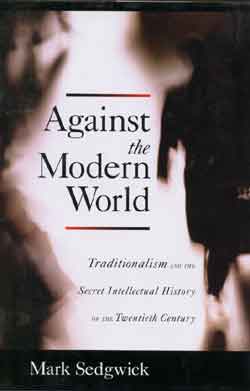
Mark Sedgwick. Against the Modern World: Traditionalism and the Secret Intellectual History of the Twentieth Century.

Against the Modern World is the first history of Traditionalism, and important yet surprisingly little-known twentieth-century anti-modern movement. Compromising a number of often secret but sometimes very influential religious groups in the West and in the Islamic world, it affected mainstream and radical politics in Europe and the development of the field of religious studies in the United States, touching the lives of many individuals. Although its appeal in the West was ultimately limited, Traditionalism has wielded enormous influence in the field of religious studies. Against the Modern World tells the previously untold story of how this far-flung intellectual movement helped shape twentieth-century religious life, politics, and scholarship, all the while remaining invisible to outside observers.
“Mark Sedgwick shows how Traditionalism is a major influence on religion, politics,even international relations. Famous scholars, theosophist and masons, Gnostic ascetics and Sufi sheikhs jostle with neo-fascists, terrorists, and Islamists in their defection from a secular, materialist West. As a study of esotericism and Western images of the East, Against the Modern World compares in importance with Edward Said’s monumental Orientalism. Likewise, it deserves the widest readership.” --Nicholas Goodrick-Clarke, author of Black Sun and The Occult Roots of Nazism.
(New York: Oxford University Press, June 2004).
384 Pages www.oup.co.uk
ISBN 0-19-515297-2
Arthur Versluis. Restoring Paradise: Western Esotericism, Literature, Art, and Consciousness.
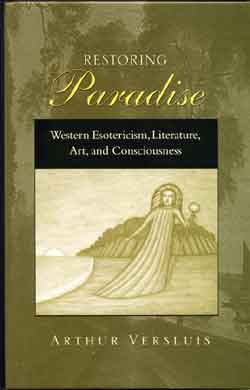
Focusing on how spiritual initiation takes place in Western esoteric religious, literary, and artistic traditions from antiquity to the present, Restoring Paradise provides an introduction to Western esotercism, including early modern esoteric movements like alchemy, Christian theosophy, and Roisicrucianism. The author argues that European and American literature and art often entail a written transmission of spiritual knowledge in which writing itself works to transmute consciousness, to generate, provoke, or convey spiritual awakening. He focuses on several important figures whose work has not received the attention it deserves, including the American writer and Imagist poet H. D. And the British painter Cecil Collins, among others. While Arthur Versluis presents a new way of understanding Western esotericism in a contemporary light, above all he has crafted a book about knowing, and about how we have come to know, and what “knowing” by way of literature and language actually means.
A volume in the SUNY series in Western Esoteric Traditions
edited by David Appelbaum
(Albany: State University of New York Press, 2004).
174 Pages.www.sunypress.edu
ISBN 0-7914-6139-4
Tom Cheetham. Green Man, Earth Angel: The Prophetic Tradition and the Battle for the Soul of the World.
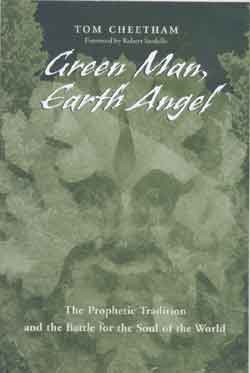
Green Man, Earth Angel explores the central role of imagination for understanding the place of humans in the cosmos. Tom Cheetham suggests that lives can only be completely whole if human beings come to recognize that the human and natural worlds are deeply interconnected.
“Cheetham gives a very good overview of the many problems of scientific rationalism as they connect to monotheism and Christian teleological thinking. In contrast, he offers a new interpretation of ecology that is aesthetic and soulful, based on the writings of Henry Corbin.”--Lee Irwin, author of Awakening to Spirit: On Life, Illumination, and Being
(Albany: State University of New York Press, 2005).
161 Pages. www.sunypress.edu
ISBN 0-7914-6269
Marsha Keith Schuchard. Restoring the Temple of Vision: Cabalistic Freemasonry and Stuart Culture.
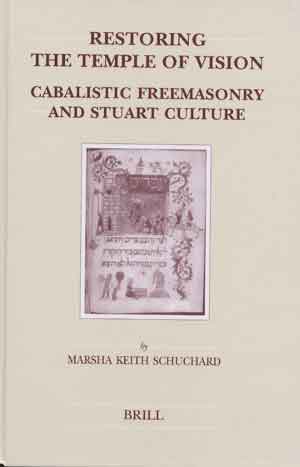
This book uncovers the early Jewish, Scottish, and Stuart sources of “ancient”, Cabalistic Masonic themes that emerged in Écossais lodges in the eighteenth century. Drawing on architectural, technological, political, and religious documents, it provides the real-world, historical grounding for the flights of visionary Temple building that were later expressed in the rituals of “high-degree” Freemasonry. While tracing the concepts of Solomonic architecture, Hermetic masques, and Roiscrucian science from their Jewish origins through their Stuart development in 1695, the author explains the persistent and potent attraction of early Scottish Masonry.
Marsha Keith Schuchard, Ph. D. (1975) in English, University of Texas at Austin, has published extensively on eighteenth-century Cabalistic and “illuminist” Freemasonry and its influence on Swift, Ramsay, Swedenborg, and Blake.
Part of Brill’s Studies in Intellectual History, Volume 110.
(Leiden: Brill, 2002).
845 pages. www.brill.nl
ISBN 90-04-12489-6
Sophie Page. Magic in Medieval Manuscripts.

Magic in Medieval Manuscripts explores the place of magic in the medieval world, examining representations of the magician, wise-woman, and witch, magical objects and ritual procedures. It is illustrated throughout from The British Library’s extensive collections, and shows how magic texts and images formed part of life in the Middle Ages.
(The British Library, 2004).
64 pages.www.bl.uk
ISBN 0-7123-4813-1.
Vladimir Solovyev. Transformations of Eros.

Vladimir Solovyev(1853-1900) is one of the most influential of Russian philosophers, and his most well-known writings outlined his philosophy of love. In Transformations of Eros, Solovyev guides the readers through and intellectual and spiritual journey from a Platonic to a Christian understanding of eros, from a partial to a complete understanding of love. As Javro Lavrin puts it, “Solovyev’s entire work can best be described as a continuous endeavor to reconcile philosophic, religious, and scientific thought in an organic synthesis.”
(St. Paul: New Grail, 2004)
103 Pages. www.grailbooks.org
ISBN 1-59650-001-8
Johann Georg Gichtel. Awakening to Divine Wisdom: Christian Initiation Into Three Worlds.
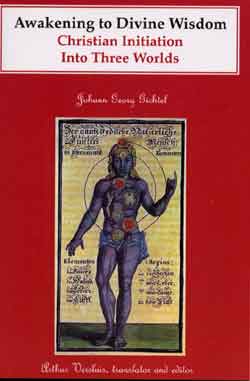
Johann Georg Gichtel(1638-1710) is one of the greatest mystics in the theosophic school of Jakob Böhme, and Awakening to Divine Wisdom is his introduction to this tradition of mystical practice based on devotion to Sophia, or Divine Wisdom. This work is most well-known for its central illustrations that depict the transmutation of the inner dimensions of the body through spiritual awakening, and some have even claimed that these illustrations show the Christian parallel to Asian traditions concerning the chakras. Without a doubt, in Awakening to Divine Wisdom, Gichtel offers his most concise and direct guide to Christian mystical practice. This is a classic work of mysticism, and should be in the library of anyone interested in this field.
Translated and edited by Arthur Versluis.
(St. Paul: New Grail, 2004).
144 Pages.www.grailbooks.org
ISBN 0-9650488-2-9
Jeremy Nadler. Shamanic Wisdom in the Pyramid Texts: The Mystical Tradition of Ancient Egypt
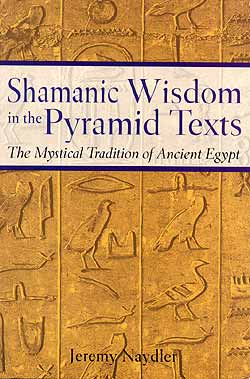
Jeremy Naydler, Ph.D., is a philosopher who has for many years been interested in the religious life of ancient cultures, receiving his doctorate in religious studies at the University of Kent, Canterbury. He is the author of Temple of the Cosmos: The Ancient Egyptian Experience of the Sacred and Goethe on Science.
To the Greek philosophers and other peoples of the ancient world, Egypt was regarded as the home of a profound mystical wisdom. While there are many today who still share that view, the consensus of most Egyptologists is that there is no evidence that a mystical tradition existed in ancient Egypt. This book presents the evidence by radically reinterpreting the Pyramid Texts--the earliest body of religious literature that has survived from ancient Egypt--and the ritual context to which these texts belong. Until now, the Pyramid Texts have been viewed primarily as royal funerary texts that were used in the liturgy of the dead pharaoh or to aid him in his afterlife journey. In Shamanic Wisdom in the Pyramid Texts, Naydler argues that they are mystical texts that speak of the experiences not of the dead but of the living king. Thrust into extreme psychological and existential predicaments and undergoing perilous encounters with alternate realities, the experiences of the king are remarkably similar to those described in the literature of shamanism. Far from expressing ancient Egyptian funerary beliefs, the Pyramid Texts are revealed as initiatory texts that give voice to a potent shamanic wisdom, which provides the key to understanding both the true nature of these experiences and the basis of ancient Egyptian mysticism.
(Rochester: Inner Traditions, 2005).
466 pages. www.InnerTraditions.com.
ISBN 0-89281-755-0.
Fred Nadis. Wonder Shows:Performing Science, Magic, and Religion in America.
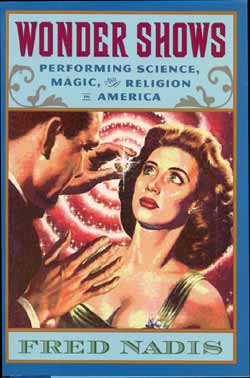
In Wonder Shows, Fred Nadis offers a colorful history of these traveling magicians, inventors, popular science lecturers, and other presenters of “miracle science” who revealed science and technology to the public in awe-inspiring fashion. The book provides an innovative synthesis of the history of performance with a wider study of culture, science and religion from the antebellum period to the present.
Nadis argues that the sensation that these entertainers provided became an antidote to the alienation and dehumanization that accompanied the rise of modern America. Nadis establishes that contemporary showmen, corporate publicists, advertisers, and popular science lecturers are not that unlike the magicians and mesmerists of years ago.
(New Brunswick: Rutgers University Press, 2005).
318 pages.
ISBN 0-8135-3515-8.
Inge Jonsson. A Drama of Creation: Sources and Influences in Swedenborg’s Worship and Love of God
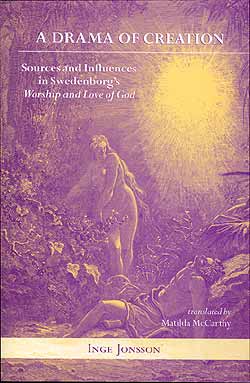
The Worship and the Love of God is one of Swedenborg’s most unusual books. A “poetic novel”, it dramaticizes the Creation and examines the life of Adam and Eve as the first truly united couple. Considered Swedenborg’s last work before his spiritual renewal, the work was left unfinished by its author as he proceeded to his great calling of unlocking the secrets of the Bible.
Inge Jonsson, one of the world’s leading scholars on Swedenborg’s works, offers a scholarly look into a neglected literary achievement. He examines this unique work from the perspective of sources and influences. The literary genre of the hexameron, ancient and modern philosophy, and scientific discoveries in the seventeenth and eighteenth centuries come into play in Swedenborg’s richly imagined and beautifully articulated world. Yet The Worship and Love of God also offers an intriguing glimpse into Swedenborg’s future as biblical exegete and revelator.
translated by Matilda McCarthy
(Swedenborg Foundation Publishers, 2004).
360 pages.
ISBN 0-87785-315-0